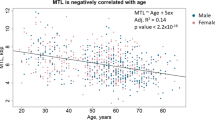Abstract
Genetic anticipation is the increased incidence, earlier onset, or increased severity of a disease in successive generations. Before the biological basis of anticipation had been demonstrated, the phenomenon was thought to be due to sampling bias, epigenetic effects, gene conversion, or recombinant events. Since then, the biologic basis for anticipation in a number of neurodegenerative disorders has been shown to be attributable to trinucleotide repeat instability, with expansion of repeats clearly correlated with an earlier age of onset. Recently, telomere shortening has been suggested as the mechanism for anticipation in the autosomal dominant form of dyskeratosis congenita, attributable to mutations in the TERC gene, leading to dysfunctional telomeres (Vulliamy et al. 2004). However, the pattern of anticipation has been observed in other disorders, including cancers, for which no genetic defect has been identified. In this study, we assess the apparent generation effect on cancer incidence in ten extended families with P53 germline mutation, identified through probands diagnosed with childhood sarcoma. The probands were from two sets of systematically ascertained sarcoma patients treated at the University of Texas M. D. Anderson Cancer Center between 1944 and 1982. From those overall studies, we have identified ten kindreds having germline P53 mutations in more than one generation. We compared the cancer incidence in members of successive generations of these families with P53 mutations (carriers) and with no P53 mutations (noncarriers). In carriers, cancer incidence increased in succeeding generations; there was no evidence for this effect in noncarriers; however, the noncarrier population was too small to rule it out. The apparent lack of increase in incidence in noncarriers argues against a cohort effect explaining the increase in carriers.






Similar content being viewed by others
References
Brook JD, McCurrach ME, Harley HG, Buckler AJ, Church D, Aburatani H, Hunter K et al. (1992) Molecular basis of myotonic dystrophy: expansion of a trinucleotide (CTG) repeat at the 3′ end of a transcript encoding a protein kinase family member. Cell 68:799–808
Brown BW, Spears FM, Levy LB (2002) The log F: a distribution for all seasons. Comput Stat 17:47–58
Efron B, Tibshirani RJ (1993) An introduction to the bootstrap. Chapman and Hall, NY
Evans SC, Mims B, McMasters KM, Foster CJ, deAndrade M, Amos CI, Strong LC, Lozano G (1998) Exclusion of a p53 germline mutation in a classic Li-Fraumeni syndrome family. Hum Genet 102:281–286
Fleisher B (1918)Über myotonische Dystrophie mit Katarakt: Eine hereditäre, familiäre Degeneration. Arch Opthalmol 96:91–133
Horwitz M, Goode EL, Jarvik GP (1996) Anticipation in familial leukemia. Am J Hum Genet 59:990–998
Horwitz M, (1997) The genetics of familial leukemia. Leukemia 11:1347–1359
Howeler CJ, Busch HF, Geraedts JP, Niermeijer MF, Stall A (1989) Anticipation in myotonic dystrophy: fact or fiction? Brain 112:779–797
Hwang S-J, Lozano G, Amos CI, Strong LC (2003) Germline p53 mutations in a cohort with childhood sarcoma: sex differences in cancer risk. Am J Hum Genet 72:975–983
Kalbfleisch JD, Prentice RL (1980) The statistical analysis of failure time data. Wiley, NY
King, M-C, Marks JH, Mandell JB (2003) Breast and ovarian cancer risks due to inherited mutations in BRCA1 and BRCA2. Science 302:643–646
Li FP, Fraumeni JF Jr (1969) Soft-tissue sarcomas, breast cancer, and other neoplasms. A familial syndrome? Ann Intern Med 71:747–52
Lustbader ED, Williams WR, Bondy ML, Strom S, Strong LC (1992) Segregation analysis of cancer in families of childhood soft-tissue sarcoma patients. Am J Hum Genet 51:344–356
Malkin D, Li FP, Strong LC, Fraumeni JF Jr, Nelson CE Jr, Kim DH, Kassel J, Gryka MA, Bischoff FZ, Tainksy MA, Friend SH (1990) Germ line p53 mutations in a familial syndrome of breast cancer, sarcomas, and other neoplasms. Science 250:1233–1238
McInnis MG (1996) Anticipation: an old idea in new genes. Am J Hum Genet 59:973–979
Monson RR (1974) Analysis of relative survival and proportional mortality. Comput Biomed Res 7:325–332
Mott FW (1910) Hereditary aspect of nervous and mental diseases. Brit Med J 2:1013
Mott FW (1911) A lecture on heredity and insanity. Lancet 1:1251–1259
Penrose LS (1948) The problem of anticipation in pedigrees of dystrophia myotonica. Ann Eugen 14:125–132
Surveillance, Epidemiology, and End Results (SEER) Program (http://www.seer.cancer.gov) Public-Use Data (1973–2000), National Cancer Institute, DCCPS, Surveillance Research Program, Cancer Statistics Branch, released April 2003, based on the November 2002 submission.
Strong LC, Stine M, Norsted TL (1987) Cancer in survivors of childhood soft tissue sarcoma and their relatives. J Natl Cancer Inst 79:1213–1220
Trkova M, Kladikova M, Kasal P, Goetz P, Sedlacek Z (2002) Is there anticipation in the age at onset of cancer in families with Li-Fraumeni syndrome? J Hum Genet 47:381–386
Vulliamy T, Marrone A, Szydlo R, Walne A, Mason PJ, Dokal I (2004) Disease anticipation is associated with progressive telomere shortening in families with dyskeratosis congenita due to mutations in TERC. Nat Genet 36(5):447–449
Yuille MR, Houlston RS, Catovsky D (1998) Anticipation in familial chronic lymphocytic leukemia. Leukemia 12:1696–1698
Wiernik PH, Ashwin M, Hu X, Paietta E, Brown K (2001) Antiicipation in familial chronic lymphatic leukemia. Br J Haematology 113:407–414
Acknowledgements
This work was supported in part by grants CA34936, CA16672, and CA57730 from the National Cancer Institute. The authors thank Christopher Brauner for his significant computational effort in this project.
Author information
Authors and Affiliations
Corresponding author
Rights and permissions
About this article
Cite this article
Brown, B.W., Costello, T.J., Hwang, SJ. et al. Generation or birth cohort effect on cancer risk in Li–Fraumeni syndrome. Hum Genet 118, 489–498 (2005). https://doi.org/10.1007/s00439-005-0016-x
Received:
Accepted:
Published:
Issue Date:
DOI: https://doi.org/10.1007/s00439-005-0016-x




